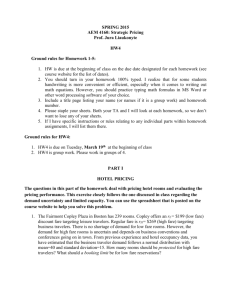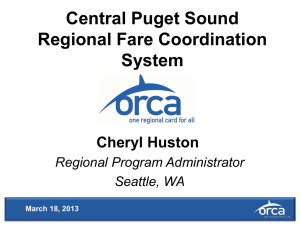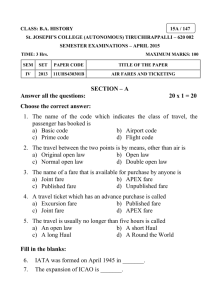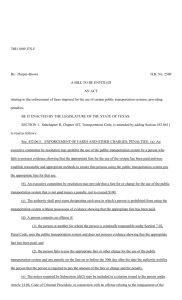Lecture 13 Slides
advertisement
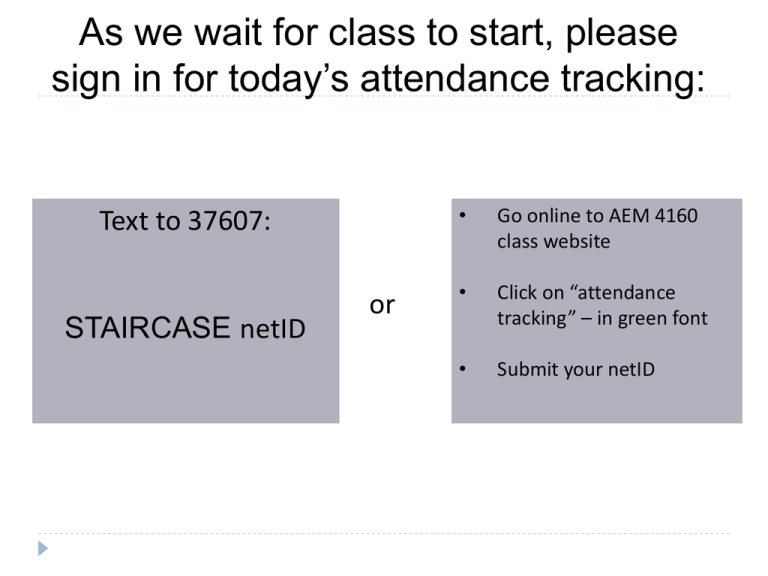
As we wait for class to start, please
sign in for today’s attendance tracking:
Text to 37607:
STAIRCASE netID
or
•
Go online to AEM 4160
class website
•
Click on “attendance
tracking” – in green font
•
Submit your netID
Lecture 13:
Advanced Booking and Capacity Constraints
AEM 4160: Strategic Pricing
Prof. Jura Liaukonyte
2
Lecture Plan
HW3, HW 4
Exam 2
Finish Gardasil
Advanced Booking
Calculating Cost per QALY
Cost Per QALY = Cost of a quality life year
Step 1: Consider the costs per person:
Cost per dose: ___________________
Cost per administration:_____________
Number of doses: _____________________
Total cost per patient: __________________
Step 2
Additional QALYs per person
At age 50, further life expectancy without cervical cancer:______
QALY per year: __________________________________________
Total QALYs: ____________________________________________
At age 50, further life expectancy with cervical cancer: ________
QALY per year: ___________________________________________
Total QALYs: _____________________________________
Step 2
Reduction in QALYs with cervical cancer:_________________
Gardasil prevents:______________________________
Gardasil incremental QALYs: ________________
Chance of Getting cervical cancer without Gardasil: _________
Incremental QALYs per person: _______________________
Cost per QALY:
Vaccination: _____________________________________
QALY: ____________________________________
Cost per QALY:___________________________
Step 2a
This was a rough calculation because it left out an
important piece of a puzzle:
COST SAVINGS
Fewer Pap tests
Fewer LLETZ procedures
Fewer cervical cancers to treat
Step 2a
Calculate COST savings
Chance that a woman will have CIN 1: ______________
Chance that a woman will have CIN 2/3:______________
Chance that a woman will have cervical cancer: ___________
Cost to treat CIN 1: ________$55______________
Cost to treat CIN2/3: _____________________
Cost to treat cervical cancer: ________________
Saved Costs per person
CIN 1: __________________________________
CIN 2/3: ________________________________
Cervical cancer: ___________________________
Gardasil will prevent (estimates):
CIN 1: 50%
CIN 2: 70%
Cervical Cancer: 70%
Calculate Total Savings:
CIN 1: ____________________
CIN 2/3: ____________________
Cervical cancer: _________________
TOTAL SAVINGS: ______________________
Savings Now or Later?
Vaccine given (average or target): __________
Cancer prevents: _______________
Difference: ___________________
Discount the cost savings at say, 8% = $16.50
In excel the command would be: =PV(0.08, 43, ,-450.2)
Savings later
So the total is:
Cost per person: _______________
Savings per person: ___________
QALY per person: 0.038
COST per QALY:__________________
Do the risks of a PR backlash and the need to grow quickly outweigh
the benefits of a higher price
Potential entrant is coming (Cervarix approved by FDA in 2009)
Patent is not forever
$360 Too Low or Too High?
Suppose prices are set so that cost of QALY is $30,000
What is the maximum price that could be set?
x = cost per person
_____________________
_____________________
_____________________
Advanced Booking and Capacity Constraints
1
4
Dynamic Pricing
Dynamic pricing is a blanket term for any shopping
experience where the price of an item fluctuates
frequently based on complicated algorithms.
A retailer might frequently change the price of an item
based on consumer demand, price fluctuations at a
competing retailer, or even the time of day and weather
conditions.
Dynamic pricing can be found in a wide variety of
industries.
Dynamic Pricing
One segment on the rise with dynamic pricing is
professional sports with Real Time Pricing.
E.g., the St. Louis Cardinals set their ticket price algorithms
based on factors like team performance, pitching match ups,
weather, and ticket demand.
Dynamic Pricing
In certain grocery stores, the price consumers pay for the
exact same product can differ based on personal data
collected through loyalty card programs.
At a Safeway in Denver, a 24-pack of Refreshe bottled water
costs $2.71 for Customer A. For Customer B, the price is
$3.69.
The difference? The vast shopping data Safeway maintains on
both customers through its loyalty card program.
Customer A has a history of buying Refreshe brand products,
but not its bottled water, while customer B, a Smartwater
partisan, is unlikely to try Refreshe.
A Safeway Web site shows Customer A the lower price, which is
applied when she swipes her loyalty card at checkout
Some U.S. airline industry observations
From 95-99 (the industry’s best 5 years ever) airlines earned
3.5 cents on each dollar of sales:
The US average for all industries is around 6 cents.
From 90-99 the industry earned 1 cent per $ of sales.
Carriers typically fill 72.4% of seats while the break-even load
is 70.4%.
0
250
500
750
1000
American: DFW-LAX All Tickets Sold in 2004Q4
0
3
7
14
Days Purchased in Advance
Roundtrip Fare
Average Fare
21
The “Prime Booking Window”
Don’t buy your ticket too early!
Best time to buy your ticket is 54 days in advance
Advanced Selling
Requires an inverse relationship between consumer price
sensitivity and customer arrival time.
Less price sensitive customers are unwilling to purchase
in the advance period so that advance purchases are
made to only low-valuation customers
Similar to traditional models of second-degree price
discrimination.
Advanced Booking
Consumers making reservations differ in their probability
of showing up to collect the good or the service at the
pre-agreed time of delivery.
Firms can save on unused capacity costs, generated by
consumers’ cancellations and no-shows, by varying the
degree of partial refunds
Airline companies in selling discounted tickets where
cheaper tickets allow for a very small refund (if any) on
cancellations,
Whereas full-fare tickets are either fully-refundable or subject
to low penalty rates.
Advanced Booking and Partial Refunds
Partial refunds are used to control for the selection of
potential customers who make reservations but differ
with respect to their cancellation probabilities.
Capacity Constraints
Examples of fixed supply – capacity constraints:
Travel industries (fixed number of seats, rooms, cars, etc).
Advertising time (limited number of time slots).
Telecommunications bandwidth.
Size of the Dyson business program.
Doctor’s availability for appointments.
The Park Hyatt Philadelphia
118 King/Queen rooms.
Hyatt offers a rL= $159 (low fare)
discount fare targeting leisure travelers.
Regular fare is rH= $225 (high fare)
targeting business travelers.
Demand for low fare rooms is abundant.
Let D be uncertain demand for high fare
rooms.
Assume most of the high fare (business)
demand occurs only within a few days of
the actual stay.
Objective: Maximize expected revenues
by controlling the number of low fare
rooms sold.
Yield management decisions
The booking limit is the number of rooms to sell in a fare class or lower.
The protection level is the number of rooms you reserve for a fare class or
higher.
Let Q be the protection level for the high fare class. Q is in effect while selling
low fare tickets.
Since there are only two fare classes, the booking limit on the low fare class is
118 – Q:
You will sell no more than 118-Q low fare tickets because you are
protecting (or reserving) Q seats for high fare passengers.
0
118
Sell no more than the low
fare booking limit, 118 - Q
Q seats protected for
high fare passengers
The connection to the newsvendor
A single decision is made before uncertain demand is realized.
There is an overage cost:
If D < Q then you protected too many rooms (you over protected) ...
… so some rooms are empty which could have been sold to a low fare
traveler.
There is an underage cost:
D: Demand for high fare class;
Q: Protection level for high fare class
If D > Q then you protected too few rooms (you under protected) …
… so some rooms could have been sold at the high fare instead of the low
fare.
Choose Q to balance the overage and underage costs.
“Too much” and “too little” costs
As Q increases => Overage costs increase
As Q increases => Underage costs decrease
Overage cost:
If D < Q we protected too many rooms and earn nothing
on Q - D rooms.
We could have sold those empty rooms at the low fare,
so Co = rL.
Underage cost:
If D > Q we protected too few rooms.
D – Q rooms could have been sold at the high fare but
were sold instead at the low fare, so Cu = rH – rL
Balancing the risk and benefit of
ordering a unit
As Q increases by one more unit, the chance of overage increases
Expected loss on the Qth unit = Co x F(Q), where F(Q) = Prob{Demand <= Q)
Essentially: overage costs multiplied by probability of overage costs happening
The benefit of ordering one more unit is the reduction in the chance of
underage:
Expected benefit on the Qth unit = Cu x (1-F(Q))
Essentially: underage costs multiplied by probability of underage costs happening
As more units are ordered,
the expected benefit from ordering one unit decreases
while the expected loss of ordering one more unit increases.
Expected gain or loss
.
Graphical Analysis
Expected marginal benefit
of understocking
Expected marginal loss
of overstocking
Units
Expected profit maximizing order quantity
To minimize the expected total cost of underage and overage,
order Q units so that the expected marginal cost with the Qth unit
equals the expected marginal benefit with the Qth unit:
Co F (Q) Cu 1 F Q
Cu
F (Q )
C o Cu
Rearrange terms in the above equation ->
The ratio Cu / (Co + Cu) is called the critical ratio.
Hence, to minimize the expected total cost of underage and
overage, choose Q such that we don’t have lost sales (i.e., demand
is Q or lower) with a probability that equals the critical ratio
Optimal protection level
Optimal high fare protection level:
Optimal low fare booking limit = 118 – Q*
Choosing the optimal high fare protection level is a Newsvendor
problem with properly chosen underage and overage costs.
Recall: Co = rL; Cu = rH – rL
F (Q* )
Cu
r r
H L
Co Cu
rH
Hyatt example
Critical ratio:
Cu
r r 225 159 66
h l
0.2933
Co Cu
rh
225
225
Demand for high fare is uncertain, but has a normal distribution with a
mean of 30 and Standard deviation of 10.
See the Excel File Posted on the course website for calculations.
You can use normdist(Q,mean,st.dev, 1)=0.29 Excel function to solve for Q
(see column E).
Answer: 25 rooms should be protected for high fare travelers.
Similarly, a booking limit of 118-25 = 93 rooms should be applied
to low fare reservations.
WE DID NOT COVER OVERBOOKING, SO IT WILL
NOT BE ON THE TEST
Revenue Management:
Overbooking
Hold the reservation!
http://www.youtube.com/watch?v=o4jhHoHpFXc&featur
e=related
Ugly reality: cancellations and noshows
Approximately 50% of reservations get cancelled at some
point in time.
In many cases (car rentals, hotels, full fare airline passengers)
there is no penalty for cancellations.
Problem:
the company may fail to fill the seat (room, car) if the passenger
cancels at the very last minute or does not show up.
Solution:
sell more seats (rooms, cars) than capacity.
some customers may have to be denied a seat even though they
have a confirmed reservation.
Passengers who get bumped off overbooked domestic flights to
receive
Danger:
If the airline is not able to get you to your final destination within one hour of your original
arrival time, the airline must pay you an amount equal to 200% of your one-way fare, with a
maximum of $650.
According to usa.gov
Hyatt’s Problem
The forecast for the number of customers that do not show up
( X ) is Normal distribution with mean 9 and Standard Deviation
3.
The cost of denying a room to the customer with a confirmed
reservation is $350 in ill-will (loss of goodwill) and penalties.
How many rooms (y) should be overbooked (sold in excess of
capacity)?
setup:
Single decision when the number of no-shows in uncertain.
Insufficient overbooking: Overbooking demand=X>y=Overbooked
capacity.
Excessive overbooking: Overbooking demand=X <y=Overbooked
capacity.
Overbooking solution
Underage cost when insufficient overbooking
Overage cost when excessive overbooking
if X >Y then we could have sold X-Y more rooms…
… to be conservative, we could have sold those rooms at the low
fare, Cu = rL.
if X <Y then we bumped Y-X customers …
… and incur an overage cost Co = $350 on each bumped customer.
Optimal overbooking level:
Critical ratio:
F (Y )
Cu
.
Co Cu
Cu
159
0.3124
Cu Co 350 159
Optimal overbooking level
Normal Distribution
Mean=9
Standard Dev. 3
Optimal number of overbooked rooms is Y=7.
Hyatt should allow up to 118+7 reservations.
There is about F(7)=25.24% chance that Hyatt will find itself
turning down travelers with reservations.
